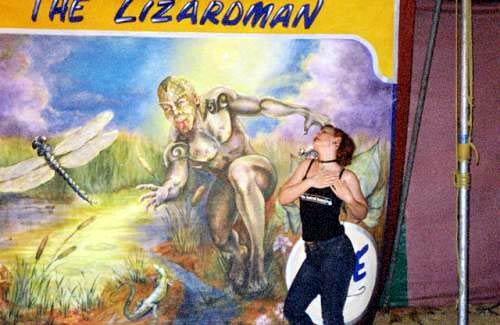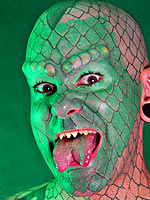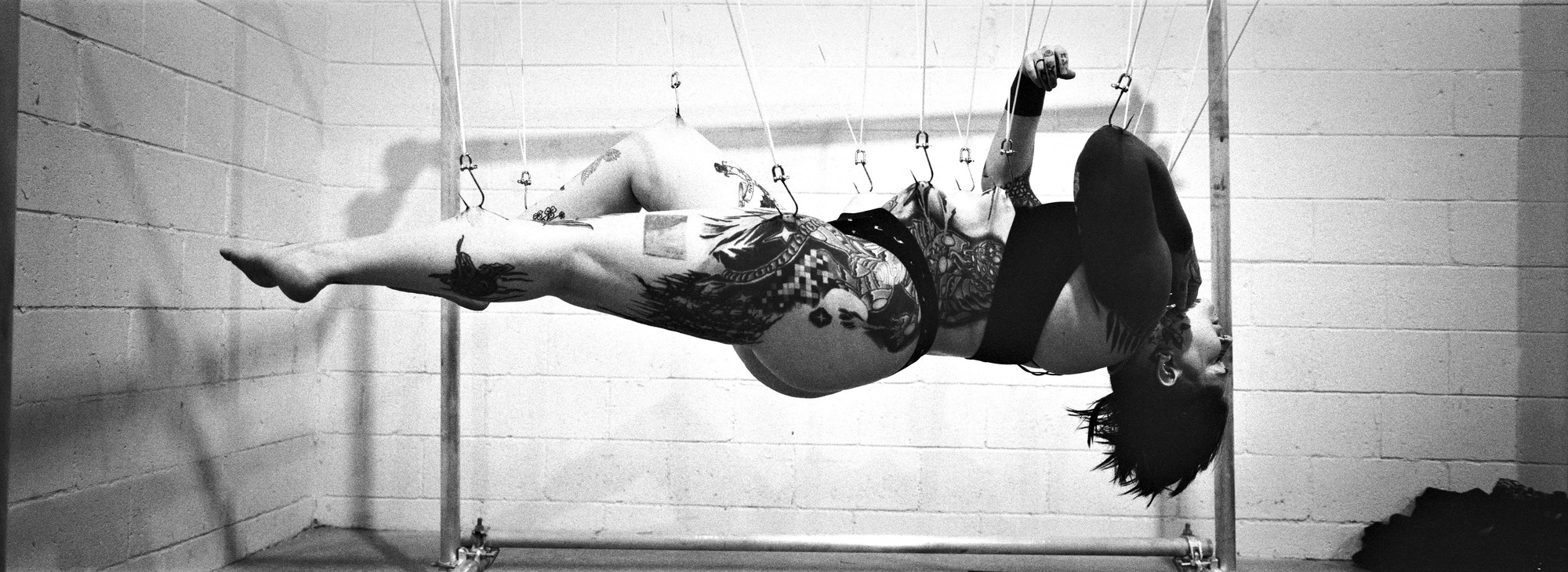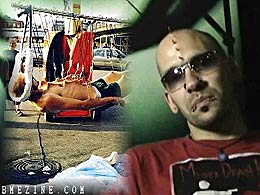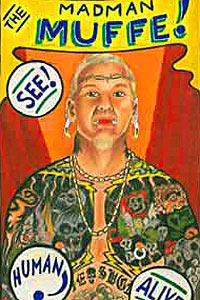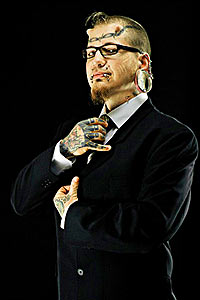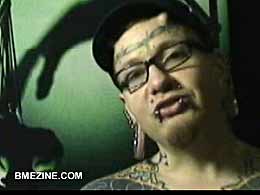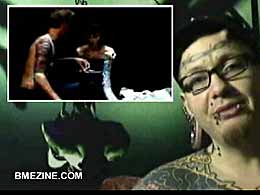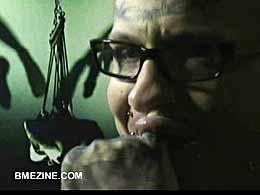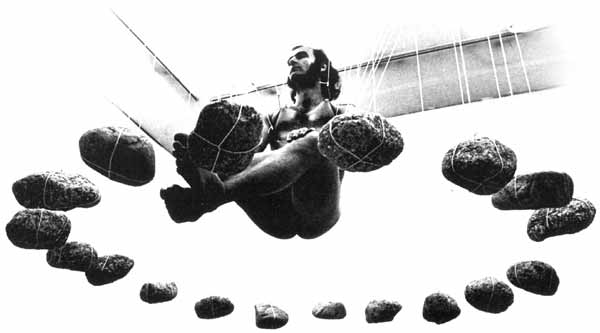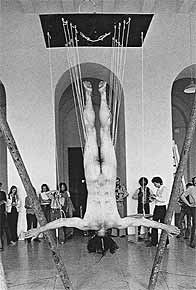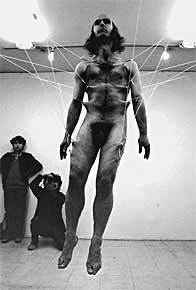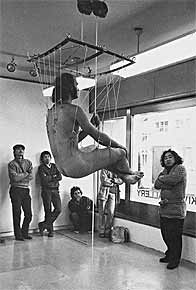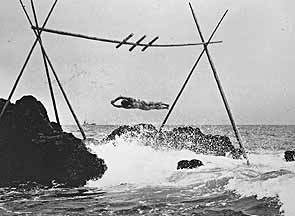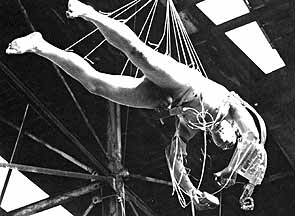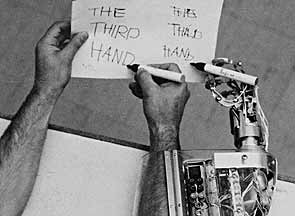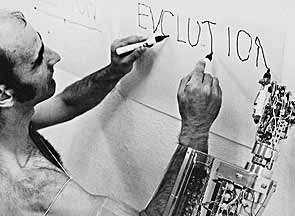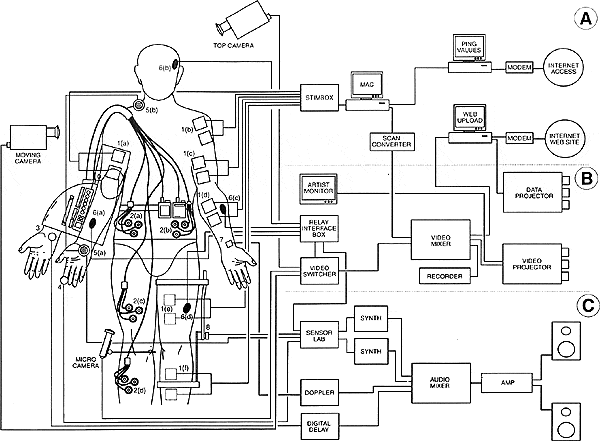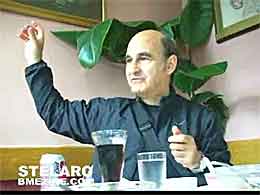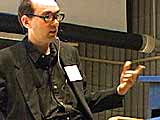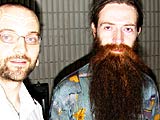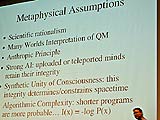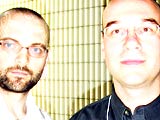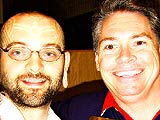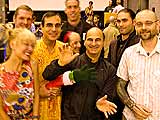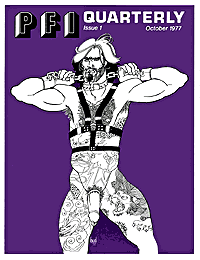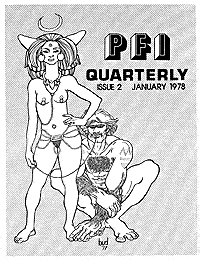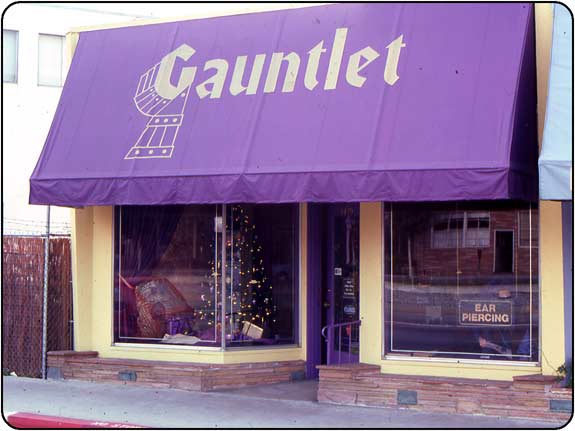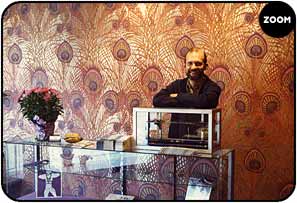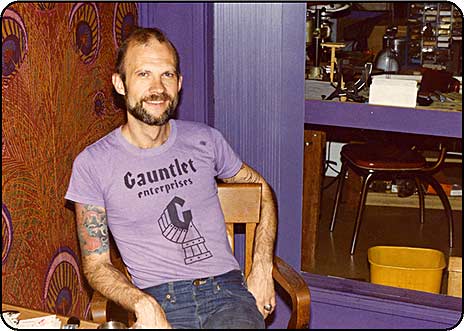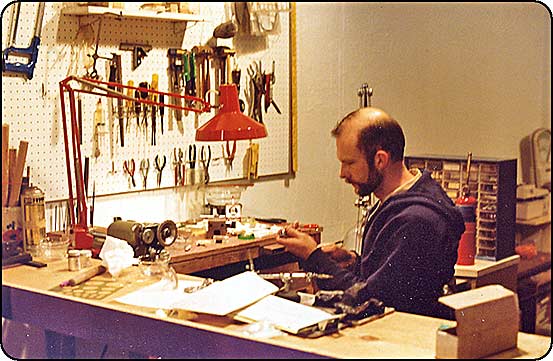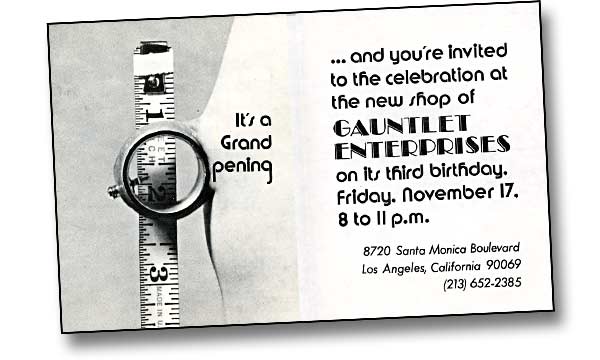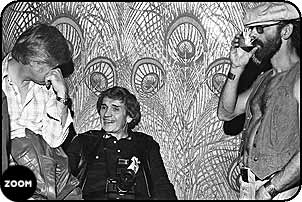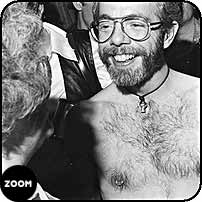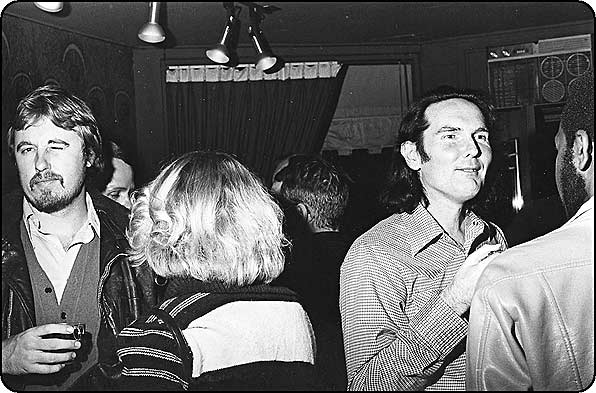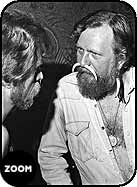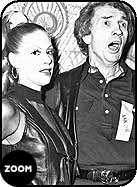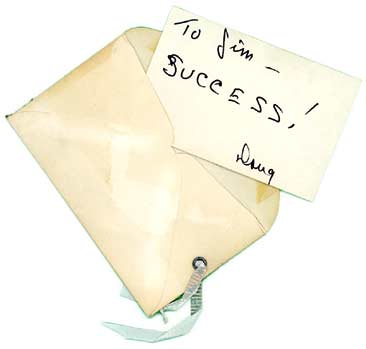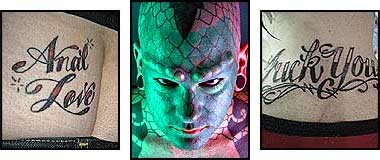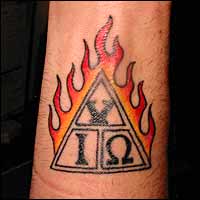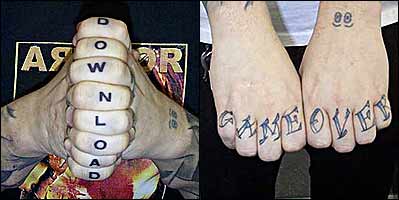
Revenge of the Tattooed Nerds
“Eccentricity has always abounded when and where strength of character had abounded; and the amount of eccentricity in a society has generally been proportional to the amount of genius, mental vigor, and courage which it contained.”
– John Stuart Mill
One of the things I love about tattooing is that it attracts interesting people from all demographics. The simple truth is that some people feel a desire to permanently mark themselves with things that profoundly affect their lives. I don’t know if this is some genetic leftover that helped primitive humans hold their social fabric together, or whether it’s an unavoidable byproduct of being both narcissistic and sentient creatures. Either way, people get tattooed every day with the things that define their lives — and “nerds” and “geeks” are no different.
Over the last couple of weeks I’ve been talking to people with “nerdy” tattoos — computer logos, video game themes, science, math, and engineering imagery. Below you can read their stories in their own words:
The Cult of Apple
While I have received the occasional Intel, AMD, and Sun tattoo pictures, as well as a few Linux Tux and FreeBSD tattoos, no computer company has as many tattooed users as Apple does. We’ll begin this article by letting a few of those people explain their Apple tattoos in their own words.
Nicole, 21, Seattle
Apple Employee
 I’ve been an Apple enthusiast since I was young, and when I was 12 years old I said my first tattoo would be the Apple logo. It was Apple and my skills in working with and fixing Macintosh computers (as opposed to PC repair, which seems to be dime a dozen) that allowed me to get a good job outside of the small town I grew up in, and allowed me to escape from that close-minded, racist place. It was also my enthusiasm for Apple that was a factor in meeting my life partner; without being Mac users, we probably wouldn’t have found such a common bond. I wanted to get the tattoo to symbolize my coming-of-age, because what it stood for was such a factor. I’ve been an Apple enthusiast since I was young, and when I was 12 years old I said my first tattoo would be the Apple logo. It was Apple and my skills in working with and fixing Macintosh computers (as opposed to PC repair, which seems to be dime a dozen) that allowed me to get a good job outside of the small town I grew up in, and allowed me to escape from that close-minded, racist place. It was also my enthusiasm for Apple that was a factor in meeting my life partner; without being Mac users, we probably wouldn’t have found such a common bond. I wanted to get the tattoo to symbolize my coming-of-age, because what it stood for was such a factor.
I actually had the logo tattooed in the September after I turned 18; that gave me nine months to get up the courage to get anything tattooed. The specific logo used is straight from an Apple sticker: size, shape and coloring. By the time I was tattooed, Apple had actually changed their corporate logo, but I had always pictured myself with the older rainbow logo. One thing that I’m quite proud of about the tattoo is the fact that no black ink was used. Every other Apple tattoo I’ve ever seen has a black outline around it. I read an anecdote from Steve Jobs (one of the founders of Apple), who was discussing the design of the logo. He insisted on having no black outline around the original logo, at great expense, but he wouldn’t settle for less. I had to shop around to find an artist willing to do it with no outline, but it was worth waiting for. It’s still as crisp and colorful three years later.
My personal reasons for having the tattoo weren’t that I was slavishly devoted to the company — I had the tattoo for reasons outside its duty as a logo. Even if the company went out of business, I had the tattoo my coming of age; and it was only a symbol of such. My feelings about Apple have become stronger after getting the tattoo; it’s always a blast to meet others with Apple tattoos, and it’s certainly a winner in “who’s geekier?” competitions. I actually started working for Apple about two years after getting the tattoo (where I’m still employed); and no, I didn’t show off the tattoo in the interview. The period between the interview and getting hired was pretty heart-wrenching; I wasn’t sure how I would feel, being rejected by the company that I have indelibly marked on my body!! Luckily, it was unfounded fear.
Apple customers can see my tattoo on a daily basis during the summer. Most customers don’t notice it (or don’t say anything), but the ones that do always love it. Everyone asks if I got it so I could get a job there. My co-workers love it as well. I showed it off in our first day of training together, and I’ve seen pictures of other employees’ tattoos.
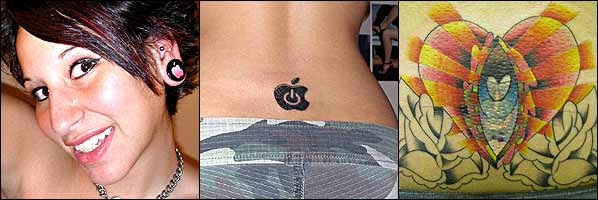
Christy, 20, Ithaca, NY
Music major
 I was never much into computers until I went to Ithaca College. My parents had a PC at home and I would use it for schoolwork, but when I went to college I bought a G3 iMac (which I later replaced with a G4 ibook) since our music program strictly uses Apple Computers. I use the computer to run music notation programs like Finale and Sibalius, but that in itself isn’t reason enough to get the logo tattooed on your body. The more I learned about the company and the people who used them, I fell in love. It sounds ever so geeky, but all of my friends use Macs, a lot of them for film editing that they do. We are all up on the latest software and hardware, and are fanatical about it. I couldn’t think of a more thrilling activity then watching Steve Jobs give his keynote presentation at the MacWorld Conference. I was never much into computers until I went to Ithaca College. My parents had a PC at home and I would use it for schoolwork, but when I went to college I bought a G3 iMac (which I later replaced with a G4 ibook) since our music program strictly uses Apple Computers. I use the computer to run music notation programs like Finale and Sibalius, but that in itself isn’t reason enough to get the logo tattooed on your body. The more I learned about the company and the people who used them, I fell in love. It sounds ever so geeky, but all of my friends use Macs, a lot of them for film editing that they do. We are all up on the latest software and hardware, and are fanatical about it. I couldn’t think of a more thrilling activity then watching Steve Jobs give his keynote presentation at the MacWorld Conference.
For a long time I just didn’t have anything that I felt strongly enough to tattoo on my body. Then I decided to tattoo an Apple on me! It just embodies everything that I am. It is more than just a computer logo to me. Apple computers are beautiful. I love design. I love to look at beautiful things. Architecture, fine art, interior design, superb tattooing, I just love it all. Apple gets it — they make beautifully designed products, and that is what I am about. The other main factor is when I think of Apple computers, I think of my friends and I smile. I met a lot of them through rendezvous on ichat at my school, and they mean the world to me. I didn’t get an Apple logo tattooed on me because I claim to be the goddess of computers, but what the logo has come to mean to me, and when a little Apple can make you smile so much, why shouldn’t it be tattooed on your body?
I had a “friend” design the tattoo for me though. As time progressed, we “grew apart”, and when I looked at my back I couldn’t think of all the happy things that it meant to me, just fighting and tears. I had to get it off of my back. I should have just left it as Apple designed it. I covered it up with an old school piece, which still isn’t finished. I most definitely am going to get another Apple logo though, on a different part of my body, which you may or may not ever see 😉
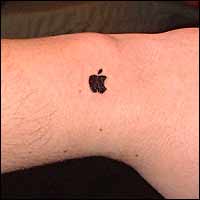
Sam, 30, Canada
Mac Consultant
 I first started using the family Apple IIe computer in 1984 and used it exclusively while I lived in England until 1992. When I came home to Canada, I started using a Macintosh LC II as it would provide a similar setup to what I was used to. A year later my first computer was an Apple PowerBook 160. In 1995 I started tinkering with friends’ computers and by 1996 I started charging money for my services. I first started using the family Apple IIe computer in 1984 and used it exclusively while I lived in England until 1992. When I came home to Canada, I started using a Macintosh LC II as it would provide a similar setup to what I was used to. A year later my first computer was an Apple PowerBook 160. In 1995 I started tinkering with friends’ computers and by 1996 I started charging money for my services.
In 1999, I moved to Ottawa to become a Macintosh computer consultant working solely on Macintosh computers. In 2001 one of my service calls was to fix an iMac at One Body Piercing in Ottawa. This was when I started thinking about the body mod world. I thought it was cool and decided an Apple tattoo would be the natural choice given that it’d been a part of my life for almost twenty years. I always that Apple was to the computer industry what Harley Davidson was to the motorcycle industry — the definition of perfection. Besides, bikers have Harley tats and not Kawasaki, so why not an Apple tat for me?
I early 2002 I moved out of Ottawa, quit my job, and started my own Macintosh consultancy business. On my 29th birthday I went and got the Apple tattoo done. I never really cared about the pain because it wouldn’t last long. I didn’t want to get a tattoo that was too big, so one that’d hide under my watch was perfect. I was thinking about an outline that I’d get filled in later, but when I found out that the outline would cost the same as the filled in version, I got it filled in.
The few customers that I have shown my Apple tattoo seem to notice the logic of it, but I haven’t had any negative reactions towards it, except from my mother, but she’s okay with it now.

Joseph, 23, Upstate NY
Computer repair technician
 My parents made me learn to type over summer vacation when I was about seven. The next year, I was required to learn TI Basic (on a TI 99/4a). There were computers available to me ever since I can remember. I learned how to write code, and the computer became something completely different, something much more useful. It seemed as if they could do anything. My first real job was working as “student help” at a school (where I work again now) installing network wiring and loading new computers for student use. Only for brief periods have I done anything else, and not because I wanted to. My parents made me learn to type over summer vacation when I was about seven. The next year, I was required to learn TI Basic (on a TI 99/4a). There were computers available to me ever since I can remember. I learned how to write code, and the computer became something completely different, something much more useful. It seemed as if they could do anything. My first real job was working as “student help” at a school (where I work again now) installing network wiring and loading new computers for student use. Only for brief periods have I done anything else, and not because I wanted to.
I thought about the tattoo for a long time, and thought it would be kind of funny in a way, but also seriously considered it’s impact on my life and on my future. I finally decided I really didn’t want to have a job outside of computers in the first place. Fellow geeks should be able to understand a tattoo like this, shouldn’t they? I had rationalized that it wouldn’t really hold me back if I stayed in the computer field, and if I wasn’t in the computer field, it would be a constant reminder that I wasn’t doing what I really love. I don’t have any regrets.
When I initially approached the artist he was very excited, and we came up with the idea of an oval shaped plate missing from my forehead with a hole showing a computer inside. We discussed how the use of “torn flesh” had become common and expected. It was unanimously decided that we would use shattered bone as the outline for the opening. We got together later with a few photographs of parts as well as some real computer parts and I showed him some of the basics. I pointed out the important pieces that I required in the tattoo. I let him do the rest on his own and when I returned he had the tattoo drawn up. I don’t remember having any complaints about what he drew up, but I had to remind him what color some of the parts were during the process. It ended up being a computer processor in the center (the processor is a bare 500 mhz Motorola MPC 7400 chip) with two memory chips on one side and some surface mount parts on the other side on a green circuit board.
People have very mixed reactions about it. Most of them are good, but some people don’t seem to grasp the concept of the tattoo at all and have difficulty understanding why I would do something like that. I don’t often let people see it to maintain a low profile. I know for certain there are people I work with that don’t know I have it. People do occasionally ask why I didn’t get it tattooed on my ass or something, but I can’t understand why someone would ask as question like that if they understood what it was.
Zelda’s Army
Video game tattoos are probably by far the most common “tech” tattoos that are sent in to BME. While nearly every game and every character is tattooed on someone, two game franchises absolutely dominate in numbers: The Legend of Zelda and Quake, with Zelda-themed tattoos having by far the most profound and personal meaning to their wearers.
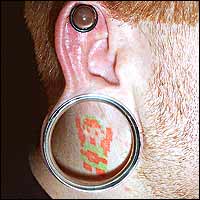
Wesley, 24, Murietta, CA
Piercer at The Electric Chair
 Link, from the legend of Zelda, this guy was my brother growing up. I’m from a generation of latchkey kids who had the Seavers for parents and video games as baby sitters. Not to mention that I am still an avid fan of 8-bit video games. Be it playing them on an emulator or just washing the old cartidges off with rubbing alcohol and using one of my two NES systems. Link, from the legend of Zelda, this guy was my brother growing up. I’m from a generation of latchkey kids who had the Seavers for parents and video games as baby sitters. Not to mention that I am still an avid fan of 8-bit video games. Be it playing them on an emulator or just washing the old cartidges off with rubbing alcohol and using one of my two NES systems.
How happy was everyone who played this game when they got a piece of Tri-force, a bomb, or pretty much any item in that game for the first time? I can recall it almost as well as I can recall my first kiss. So it was a no-brainer that celebrating Link was what I wanted tattooed on me. I hunted down the image on the internet and took it to Kim Durham. We tried placing it normally, but since I wanted to make sure that you could see it through my ear tunnels, so I put my plug back in and we used my ear to draw a circle on my neck then placed the transfer in the circle.
This stands as one of my favorite tattoos. It also doesn’t hurt that it’s one of my most complimented tattoos. The colors are vibrant enough to attract attention, and any person who sees it wants to wax nostalgic about one of my favorite conversation subjects; old video games!
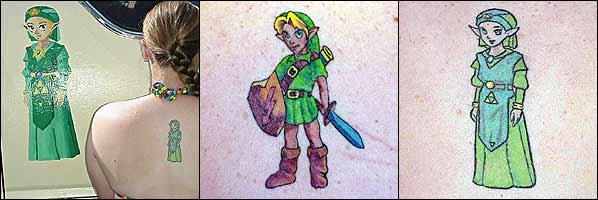
Kathy, 22, Oregon
Botany/Chemistry Student
 My twin and I grew up with a few best friends, and one of them was a boy named Kenny who we liked to play video games with. Mostly Zelda, but others as well. We would watch the Zelda cartoons on TV and dress up like the characters for Halloween and pretend to be the characters when we were playing. Kenny was always Link, Becky (my twin) was Zelda, and I was always Sprite. I was a little put off about always being the minor character, but we expanded the role when necessary. As more Zelda games came out we kept buying them and playing them, but the original was always my favorite. I painted my car like the map of the original. I do not play the game all the time, or hardly at all anymore, being busy with school, but it is a reminder of the most fun times of my childhood. My twin and I grew up with a few best friends, and one of them was a boy named Kenny who we liked to play video games with. Mostly Zelda, but others as well. We would watch the Zelda cartoons on TV and dress up like the characters for Halloween and pretend to be the characters when we were playing. Kenny was always Link, Becky (my twin) was Zelda, and I was always Sprite. I was a little put off about always being the minor character, but we expanded the role when necessary. As more Zelda games came out we kept buying them and playing them, but the original was always my favorite. I painted my car like the map of the original. I do not play the game all the time, or hardly at all anymore, being busy with school, but it is a reminder of the most fun times of my childhood.
I decided to have it tattooed about 30 seconds after my twin came home with Link tattooed on her back!
The design is the most majestic and simple official picture of princess Zelda that I could find. The color was done to be complimentary to Becky’s Link tattoo. The location was done to match Becky’s as well, though my tattoo is about an inch larger. My feelings on my childhood will never change; I will always want to remember the best parts, the imagination that made everything we did magical. So, I still love the tattoo. I wish it were in a different place, though. I can’t ever see it, and I always have to stretch to put sunblock on.
My college peers usually love it, because a lot of people my age grew up on the game. Sometimes, if they don’t understand that it symbolizes my childhood, they think I’m a bit of a fanatic…
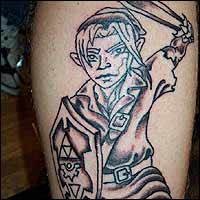
Patrick, 22
Software developer
 I wanted to get a Nintendo tattoo since video games were the primary reason I picked my profession. Zelda is definitely a game that has stood the test of time and Link is a hell of a character. I decided to put it on my leg because I’m considering doing a sleeve of Nintendo video game characters. For the design and pose, I just brought some Nintendo Powers to my artist, Nate from Everlasting Art in Philadelphia, who will be finishing it this weekend. He drew a custom piece based on the magazine and some of my vague descriptions like “I want a sort of serious look on his face.” I wanted to get a Nintendo tattoo since video games were the primary reason I picked my profession. Zelda is definitely a game that has stood the test of time and Link is a hell of a character. I decided to put it on my leg because I’m considering doing a sleeve of Nintendo video game characters. For the design and pose, I just brought some Nintendo Powers to my artist, Nate from Everlasting Art in Philadelphia, who will be finishing it this weekend. He drew a custom piece based on the magazine and some of my vague descriptions like “I want a sort of serious look on his face.”
My coworkers love it. Seriously. It’s sparked an interest in tattoos in several of them. Even my manager and the CEO don’t have any problems with it (or tattoos in general).
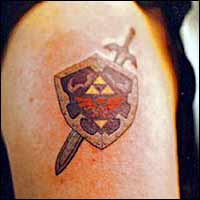
Myk, 20, BC Canada
Warehouse worker
 I was born in 1983 and four years later the greatest game of all time came out: Legend of Zelda for the NES. I played that game all day long for months and months, and still play it when I get around to it. Every Zelda game after that I have bought and beaten just reminds me so much of my childhood, so why not get a permanent reminder? I was born in 1983 and four years later the greatest game of all time came out: Legend of Zelda for the NES. I played that game all day long for months and months, and still play it when I get around to it. Every Zelda game after that I have bought and beaten just reminds me so much of my childhood, so why not get a permanent reminder?
In 1998 The Legend of Zelda: Ocarina of Time was released. It’s said to be the greatest in the whole Zelda series, which is true in my opinion. I faked sick a lot to get out of school just to play it. On the cover of the box is Link’s sword and shield which have been used in every game, but just hasn’t been shown in such detail until this game came out. I was obsessed with the design. I took the box to a local tattoo shop at 16 years old and an hour later I was sitting in the chair for the first time. The size, color and style are exactly as it looks, no change at all. I knew I wanted to get a full sleeve on my right arm one day, so I decided to get it on my left upper arm.
I don’t regret getting the tattoo, because it means so much to me, but I do regret getting it done at the place I did. I was young and just wanted a tattoo… I didn’t know I should check out other stores, check for cleanliness and so on. I now see that my Zelda tattoo is very poorly done, but it’s nothing that I can’t get touched up and make look better.

Scott, 21, Detroit Computer/Electrical Engineering Student
 I grew up as a military brat, so being on the move and having little to no friends I turned to gaming and technology. I chose to start my sleeve with the Atari symbol because Atari is what started the gaming craze. I actually probably enjoy Nintendo’s work over Atari, but I’m a fan of everything gaming. I grew up as a military brat, so being on the move and having little to no friends I turned to gaming and technology. I chose to start my sleeve with the Atari symbol because Atari is what started the gaming craze. I actually probably enjoy Nintendo’s work over Atari, but I’m a fan of everything gaming.
I’ve always wanted a tattoo sleeve, but being that I am a professional I couldn’t really go past the elbow. I wanted the brightest color I could possibly get so that’s why I chose Jime Litwalk to do my work — he is the color master. I don’t regret getting this work done. I’m a geek. You would never tell from my appearance, but the geek blood runs through me. I also have a strain of binary code tattooed on my back that spells out Apollo, the Greek god of music and philosophy. Music is another major influence in my life.
Science and Engineering
Tattoos are far from limited to “fan” artwork. While you could unfairly write off the tattoos already mentioned as no different than someone getting an Ozzy Osborne tattoo (not that there’s anything wrong with that!), many people working in science, math, and engineering, choose their own glyphs based on those professions.
Chris, 31, Melbourne
Sound engineer, drummer
 This tattoo, along with its partner on the other wrist, “wavelength = velocity/frequency” represent physical constants. They also represent the basis of my work, and of my passion. They were done at a time in my life when I desperately needed something constant, and to help me focus on a long term goal. This tattoo, along with its partner on the other wrist, “wavelength = velocity/frequency” represent physical constants. They also represent the basis of my work, and of my passion. They were done at a time in my life when I desperately needed something constant, and to help me focus on a long term goal.
I drew up several designs, and drew them on my wrists with ink, to make sure I was going to be happy with the result. I did experiment with different colors in the flames, such as blues and greens, as in a natural gas flame, but it didn’t work at all. Choosing the font for the symbols took the most experimentation.
It hasn’t affected my work at at all. I get other sound engineers asking what the formulas mean though!!
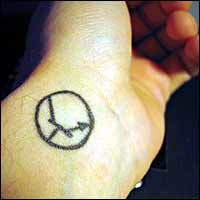
Luigi, 23, NYC
Construction Safety Inspector
 I spent four years studying electrical engineering, and I didn’t drop out to some easier subject like some other students. I graduated with a BSEE… not that you can call me a doctor, but it’s still a small accomplishment. Because of this small accomplishment, I got my tattoo. To me, the transistor revolutionized the world due to faster and smaller computers and anything else that can benefit from them. It also has to do with the fact that transistors are in just about everything. I spent four years studying electrical engineering, and I didn’t drop out to some easier subject like some other students. I graduated with a BSEE… not that you can call me a doctor, but it’s still a small accomplishment. Because of this small accomplishment, I got my tattoo. To me, the transistor revolutionized the world due to faster and smaller computers and anything else that can benefit from them. It also has to do with the fact that transistors are in just about everything.
The design is from the IEEE schematic symbol for a transistor. My feelings for the tattoo vary, but for the most part, I don’t regret it. It has had no negative impact on my professional life and can be covered by my watch when I need it to be.
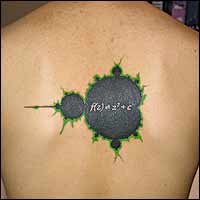
Niki, 20
Computer science and mathematics student
 My first introduction to the Mandelbrot Set occurred during my third year of high school. My pre-calculus teacher had some time towards the end of the semester to showcase some of the more interesting sides of mathematics. Of course the Mandelbrot Set (and fractals in general) were included in this mathematical menagerie and really peaked my interest. Infinite amounts of infinitesimal detail becoming increasingly more complex as small changes were made to the input. Needless to say, this laid the foundation of my fascination with mathematics. My first introduction to the Mandelbrot Set occurred during my third year of high school. My pre-calculus teacher had some time towards the end of the semester to showcase some of the more interesting sides of mathematics. Of course the Mandelbrot Set (and fractals in general) were included in this mathematical menagerie and really peaked my interest. Infinite amounts of infinitesimal detail becoming increasingly more complex as small changes were made to the input. Needless to say, this laid the foundation of my fascination with mathematics.
During my senior year of high school I was fortunate enough to have a couple of incredible teachers who acted as catalysts and really ignited my interest in math and computer science. After graduating high school I began my college career majoring in computer science and minoring in mathematics. Come fall I will be starting my third year. So far I have been very fortunate and have had many talented professors for both computer science and mathematics, for which I am very thankful.
What better way to express my love for math and computer science than to get a tattoo? And here is this Mandelbrot Set — a mathematical concept that can only be visualized using computer science! It seemed quite natural.
To make the design I wrote a program that would generate the Mandelbrot Set. I decided to shade all of the points not contained in the set green (as green is my favorite color). I had planned to have the formula scarred into my back with the image tattooed over it (and in fact I still plan on doing this). However at the time I did not know any scarification artists and opted to have the formula as part of the tattoo.
I find that more and more each day I realize how right this path is for me. Aside from my Mandelbrot Set tattoo, I also have the letter i scarred into the back of my right calf and the square root of negative one scarred into the back of my left calf (both of which represent the imaginary number). I certainly plan on getting more math and computer science related work done in the near future. My coworkers and clients who do know about it have overwhelmingly responded in a very positive manner.
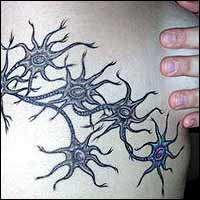
Michelle, 20, Florida
UF Brain Institute Lab worker
 My familial situation growing up wasn’t a typical one, and consequently, I often wondered about the effects it had on my mental and emotional development and state. Basically, I wanted to know why I was the way I was, and eventually, why people are the way they are. That’s why I decided to study behavioral neuroscience. My familial situation growing up wasn’t a typical one, and consequently, I often wondered about the effects it had on my mental and emotional development and state. Basically, I wanted to know why I was the way I was, and eventually, why people are the way they are. That’s why I decided to study behavioral neuroscience.
Initially, I thought of this tattoo as my own take on the symbol of the heart. I’ve come across many heart tattoos and I am always reminded about how feelings, whether physical or emotional, stem from the brain and nervous system, not the heart. The death of my grandmother was a more immediate impetus for me going to the shop and actually getting it done when I did, since the tattoo also has another more personal meaning for me.
The tattoo is six rendered neurons across the right side of my rib cage. The one closest to my front is colored in blue and purple, while the five nerve cells behind it are shaded in black. This is because the five colorless neurons represent five people in my life that I was close with that have died, and the colored one represents me. They are all connected to me, and have influenced my life, both while alive, and in their passing. I decided to get it done over my ribs because my tattoos have to be concealable (and my back is sort of reserved), as I intend to pursue a career in research work, and unfortunately, body modification tends to be discriminated against in most professional fields. I also don’t really get tattoos for other people, so if anyone else can’t see them, that’s fine with me.
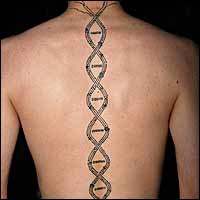
Blake, 22, Toronto
Bank Worker
 Computers and technology are so fully integrated into society, to the point that without them we wouldn’t be able to function properly. Without computers and computer related technology, we would fall apart. It’s gotten to the point where we rely on them to live… or at least live as we’ve become accustomed to living. So why not push this one step further and display the facts permanently on your body? Computers and technology are so fully integrated into society, to the point that without them we wouldn’t be able to function properly. Without computers and computer related technology, we would fall apart. It’s gotten to the point where we rely on them to live… or at least live as we’ve become accustomed to living. So why not push this one step further and display the facts permanently on your body?
Technology and computers control how we live, control our bodies and ultimately control the way we look at the world — in essence, our minds. My tattoo is the DNA double-helix encompassing the binary form of words for “MIND” and “BODY” pretty much summing up these disturbing realizations — that I’ve come to accept, rather than fight. The world of computers will one day, without a shadow of a doubt, end up like a potato bug on it’s back — taking us along with it — but at this point, there is not a damn thing we can do about it… but wait.
Whether it’s liked or not, no one will actually put a great deal of thought into anything you say when you tell it to them. Now, throw in a factor that makes a person ask you a question that involves their interest… makes them want to know (whether it be guided conversation — misdirected truths — media manipulation — or something that people like to look at, like a tattoo). You now have that persons attention, with their mind open, ready to absorb information — whether they accept it — understand it — or choose to debate. I wouldn’t be surprised if a great deal of life changes conversations started over, “Hey, nice tattoo. What is it?”.
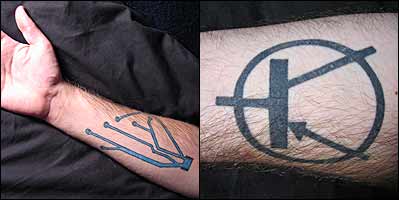
Aubrey, 20, Philadelphia
Computer Programmer
 I grew up with a biochemist for a father and a physician for a mother. Logic, rational thought, and curiosity were all things that were completely encourged in my childhood. My I grew up with a biochemist for a father and a physician for a mother. Logic, rational thought, and curiosity were all things that were completely encourged in my childhood. My
parents built a computer from a Tandy/RadioShack when I was less than a year old (maybe before I was born, I’m a bit fuzzy on those periods), so we’ve always had a computer. Putting this encouragement together with the computer resulted in me breaking, rebuilding, and understanding at least half a dozen machines since then — usually with my parents’ support.
Really, my tattoo is about my general love of information technology, and my belief that it is radically and fundamentally reshaping how humans live. We are evolving at a rate never before seen on this planet. Basically, because the time between different generations of technology is shrinking rapidly, our evolutionary progress is increasing proportionally.
I wanted a tattoo. But, I don’t feel comfortable with having a representational tattoo on me so instead I looked for designs symbolic of what I enjoy in life. I’ve always loved computers.
I’d originally wanted to have my entire scalp tattood with the schematic of an Intel 486DX2 (the first computer that was ever mine). But, due to the fact that such schematics are nearly impossible to find in a visually pleasing form, and due to their complexity, this wasn’t really going to work. I started looking for something simpler.
There’s exactly one thing responsible for me having a computer to write this on: the transistor. Had we been stuck using vacuum tubes forever, we would never have had any computer smaller than a living room, or with clock speeds faster than a few megahertz. Furthermore, the schematic symbol for a transistor is also visually interesting, and unmistakable to anyone who’s ever spent time with electronics schematics. It was,
honestly, an easy decision.
I am, and have been for a while, a transhumanist. Having people constantly asking me about my tattoos gives me the perfect chance to talk to them for a bit about my views on technology and where we should be going with it. I know that makes me sound a bit like somebody wearing a “Ask me about [Insert God X]” headband, just sitting around hoping
somebody will let me preach. But, the truth of the matter is that I preach even if people don’t ask.
I’ve been hired for jobs (where geeks had hiring and contracting power) partially because my enthusiasm for technology was made obvious by tattoos. I find it’s very easy to get someone to very quickly believe you actually do love what you’re doing when you can point at your arm and say, “Yeah, that’s a transistor. And I got it in art school.”
Clients and jobs where geeks didn’t have any power almost never “get” my tattoos. I do nothing to hide my ink or piercings from clients, and so they see them, but they almost never say anything about them. To the few who have said something, I’ve gone on and explained what a transistor is, how it works, what it does, and other such information. Any points I’ve lost for having ink tend to be made up quickly with my ability to, in five or ten sentences, tell these marketing types how a computer physically works.
Linux fans? I’m stealing this prompt to tell a brief anecdote. I just got home from the Fifth HOPE in NYC. It was amazing. But, one of the most amazing things was the number of people who understood my transistor tattoo. Up until this time, I’d kept a tally of how many people had properly identified it. It was at thirteen in three years. After just a few hours at HOPE, there was no point in counting anymore. Admittedly, I changed the rules, in that I was counting people pointing, nodding, smiling knowingly while looking at it, and so on, but it was obvious, even without precise numbers, that dozens of people understood it. Not only did they know the symbol, but they made the context jump (which engineers of the older generation never seem to do, even when they think it’s cool after it’s pointed out), and understood why I would have such a thing on my arm. It was very, very liberating, and the tradition of the count has been abolished.
8-bit Gamers
Perhaps because of the nostalgia factor, the games most often etched into permanence are older 8-bit games, and the design of the tattoo regularly reflect an embracing of this technology.

Jolene, 26, Indianapolis
IUPUI Research Associate
 I wish I could say that Galaga has been an obsession of mine ever since its inception as Galaxian for the Atari 2600, but the truth is I didn’t discover this fabulous game until I started frequenting the local arcade by my college. A friend of mine and I would go there late at night when we couldn’t sleep. We would just show up in our PJs and play Galaga until 3 AM. We fell in love with the game. It was our escape from school. I wish I could say that Galaga has been an obsession of mine ever since its inception as Galaxian for the Atari 2600, but the truth is I didn’t discover this fabulous game until I started frequenting the local arcade by my college. A friend of mine and I would go there late at night when we couldn’t sleep. We would just show up in our PJs and play Galaga until 3 AM. We fell in love with the game. It was our escape from school.
I had been thinking about getting it tattooed, but the actual decision was sort of last minute. I was in grad school, taking this class over the summer that was called “Digital Media and Pop Culture.” It was basically all about visual effects in films, the history of video games, stuff like that. On the last day of class, we had the opportunity to earn some extra credit points by sharing a story or experience having to do with movies or video games. So the night before, I went and had the Galaga fighter ship tattooed on my back, and when I told my story and showed the pictures of the process, my professor was extremely impressed. Needless to say, I earned those extra credit points.
I’ve since been planning out which aliens to include, and what challenge stages to integrate into the entire design. I’ve also decided that eventually, one day, when I retire from the game, I will tattoo my high score between my shoulder blades. As far as the design goes, I’ve been recreating all the graphics using Adobe Illustrator from pictures I’ve found online or that I’ve taken myself while playing. Since my skin is such a pale shade of white, I’m having to outline the graphics in a thin black line so they will show up better on my back (this started with the fighter ship, which is white in color, but had to be done in more of a grayish tone on my skin so it would be visible).
I still enjoy Galaga as much as I ever have. In fact, I’m probably even more cocky about my Galaga playing skills now that I have the tattoo, because it goes to show how hardcore I am about the game.
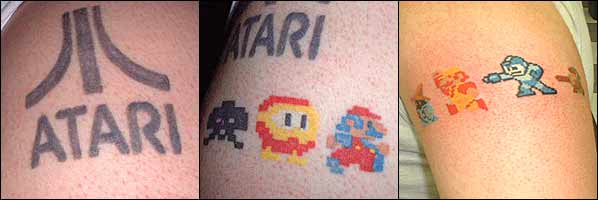
Russ, 26
Computer Engineering
 Back when arcades were hot-shit, like during the days of Mr. Do, Dig Dug, Jungle Hunt, and Berserk, my mom worked at a bowling alley on Cape Cod. The arcade in the bowling alley was loaded with video games, and also loaded with quarters. Every morning when my mom would open the alley, she would tag me along, and the service operator would come to empty the quarters out of the machines. After he rid a machine of its bounty, he would load it up with the maximum allowable free credits (usually 9). Then I’d have about an hour and a half to play free video games all morning until clients started coming in. This lasted a while before the local kids caught on that there were free video games. This was probably the nostalgia I was trying to commemorate with these tattoos. Back when arcades were hot-shit, like during the days of Mr. Do, Dig Dug, Jungle Hunt, and Berserk, my mom worked at a bowling alley on Cape Cod. The arcade in the bowling alley was loaded with video games, and also loaded with quarters. Every morning when my mom would open the alley, she would tag me along, and the service operator would come to empty the quarters out of the machines. After he rid a machine of its bounty, he would load it up with the maximum allowable free credits (usually 9). Then I’d have about an hour and a half to play free video games all morning until clients started coming in. This lasted a while before the local kids caught on that there were free video games. This was probably the nostalgia I was trying to commemorate with these tattoos.
I wanted a tattoo, and I wanted something that sort of defined me as a person. I spent a lot of time playing Nintendo when it was in its prime, and knew that my love for old school video games was never going to wane. I tend to be a huge fan of pop culture in general, so any tattoo I was going to get was going to be along those lines anyway.
On my right arm I have an Atari logo, and underneath it are four recognizable icons from the early eighties: Blinky from Pacman, a Space Invader, a Pooka from Dig Dug, and Mario from Donkey Kong. The Atari logo was my first tattoo, which reflected the first real “video games” that I ever played. The four icons below it, I felt, encapsulated a general range of the sort of thing anyone living in the arcade era could be familiar with, and I also thought those four icons were pretty representative of something I would want on my body forever.
My left arm has four icons from the Nintendo era: Link from the Legend of Zelda, Megaman, Super Fire Mario, and the Black Mage from Final Fantasy. Although they are pretty mainstream choices, I just wanted some kind of reminder that most of my early teens were spent having sleepovers and playing rented Nintendo games until 5 AM.
I don’t play a lot of newer games, so when people see the tattoos, they always assume I am a huge gaming fan, which I’m not, although I do love the oldschool. especially Robotron 2084.
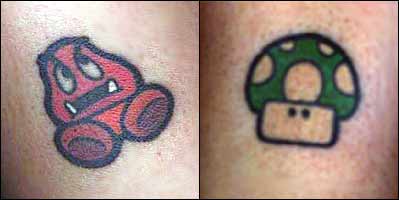
Rahima, 20, Midwest
Entrepreneurial Management and Marketing
 I still remember when I was four and my mom led me to the towering display of Nintendos at Kmart. Since then, I’ve gone through several different game systems (remember Virtua Boy?) and literally hundreds of games. I’ve had numerous other hobbies and interests, but none have stayed with me as long as video games have. Video games aren’t an obsession of mine, I only play four or five hours a week, if that, but I have always played them. I think because I haven’t become insanely obsessed with them, I haven’t have a chance to become burned out by them. I also feel that video games have been a huge part in allowing me to have a close relationship with my autistic brother. He doesn’t understand what goes on in most of the world, but he does understand video games. I still remember when I was four and my mom led me to the towering display of Nintendos at Kmart. Since then, I’ve gone through several different game systems (remember Virtua Boy?) and literally hundreds of games. I’ve had numerous other hobbies and interests, but none have stayed with me as long as video games have. Video games aren’t an obsession of mine, I only play four or five hours a week, if that, but I have always played them. I think because I haven’t become insanely obsessed with them, I haven’t have a chance to become burned out by them. I also feel that video games have been a huge part in allowing me to have a close relationship with my autistic brother. He doesn’t understand what goes on in most of the world, but he does understand video games.
While on break from college, my friend had a tattoo done, and I was insanely jealous of it, so I figured after years of wanting a tattoo, the time was right. The idea for the 1-Up mushroom just popped into my head and I instantly loved it. I figured I wouldn’t regret having the 1-Up mushroom on me when I’m older because video games represent so much of my childhood.
Most people love my tattoo and I like seeing the smiles and memories it brings back to them. Some people ask if I will regret the tattoo later on, but I really felt like it belongs on me. A month later after getting the 1-Up mushroom tattoo, I had the Goomba added on the inner part of my ankle. If anything, the tattoos serve as a great memory of my childhood, and something that I frequently look fondly at.
I do go to a rather snobbish business school, so some people are surprised by my tattoos. I know that I have potentially closed some doors with them, but I never wanted a piece of corporate America. I have thought long and hard about the possible consequences and discrimination I may face as a member of the modified community, and am ready to take on any and all of these challenges with open arms.
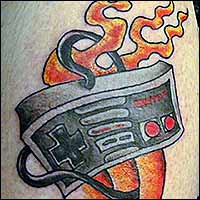
Steve, 24, Lynnfield MA
CIS Graduate
 I have always loved video games, and I like my tattoos to be something that I can smile at, and at the same time be important to me. At one point in my life I had lost a lot of friends but video games were still there for me. When I went to school I made my first friends in the school’s arcade playing Gauntlet. They are now my closest friends. Video games are also a good outlet for me because when I get mad or am in a bad mood I can play a video game suited to my mood. I can blow things up, or I can play a video game that makes me smile, or even cry. I have always loved video games, and I like my tattoos to be something that I can smile at, and at the same time be important to me. At one point in my life I had lost a lot of friends but video games were still there for me. When I went to school I made my first friends in the school’s arcade playing Gauntlet. They are now my closest friends. Video games are also a good outlet for me because when I get mad or am in a bad mood I can play a video game suited to my mood. I can blow things up, or I can play a video game that makes me smile, or even cry.
Nintendo was always something innocent. It reminds me of my childhood, and I miss the innocence that came with childhood. I originally just wanted a full sized Nintendo controller, but now my plans are to make my whole right leg a Nintendo piece — I just need more money!
Since I got my first tattoo I have become more open to people’s free expression. In my mind I was always tattooed anyway though. My feelings about people opposing the modified community have grown, and in a way it angers me. Sure it’s human nature to fear what we don’t understand but in these times we have enough problems and the last thing we need is something so petty such as this.
Other gamers
…But 8-bit gaming is far from the only kind immortalized with tattoos. As more time passes, the torch is passed to PC gamers as well.
Shan, 28, Dallas
Obscurities Counter
 Most of my tattoos spawn from childhood memories. At the age of nineteen, my uncle was paralyzed from the neck down in World War II. Every month the government would send him a large check to compensate for his disability. He would use that money to find ways to entertain himself. I lived with my uncle most of my early life. Every week some new gadget was coming in the mail. I was about six when the computer arrived; we unpacked it, and plugged it in and wow, was it amazing. As I was going through the bags I found a strange box with the word Ultima on it. My uncle not being able to really move his arms, always needed help with his toys. I was his arms and legs in a land far away, killing dragons, and collecting gold, or flying through space, discovering new alien races. Everyday after school, turned in to every night after school, and then every morning before school. If I had any free time, I was behind that machine in a different world. Most of my tattoos spawn from childhood memories. At the age of nineteen, my uncle was paralyzed from the neck down in World War II. Every month the government would send him a large check to compensate for his disability. He would use that money to find ways to entertain himself. I lived with my uncle most of my early life. Every week some new gadget was coming in the mail. I was about six when the computer arrived; we unpacked it, and plugged it in and wow, was it amazing. As I was going through the bags I found a strange box with the word Ultima on it. My uncle not being able to really move his arms, always needed help with his toys. I was his arms and legs in a land far away, killing dragons, and collecting gold, or flying through space, discovering new alien races. Everyday after school, turned in to every night after school, and then every morning before school. If I had any free time, I was behind that machine in a different world.
Most kids my age didn’t have computers; in the early eighties they were pretty expensive. Everyone else had Ataris, so of course we got one as well. The games this machine would let you play just weren’t as involved, and were really basic. I still played them, but it wasn’t until the Nintendo that I really got hooked on platform gaming. First Nintendo, then Sega (you had to have both in my neighborhood). Computers were still a rare thing, but slowly they became more inexpensive and the games were easier to find. As I grew, so did the machines, faster processors, amazing graphics, surround sound audio or 3-D realistic environments. It’s a whole new world, and you can visit it too. That’s what always attracted me, the interaction between the artificial intelligence, and the choices I could make. There are no limits. Sure you can read a book, and explore other worlds, but how often can you decide what the outcome is, and watch it all happen with your eyes, not your imagination.
Tattoos are a huge part of my life, they are my work, my memories, and the things in life that make me happy. Throughout history people have had tattoos for many different reasons. Sailors would get symbols to keep them afloat, or to remind them of that woman they met at port. Warriors would get symbols to scare their enemies or to show rank. I get tattoos that remind me of the things I love, and what I want to carry with me for the rest of my life. When I look in the mirror, or down at my body, I feel the opposite of regret. I smile and know what I have done is right.
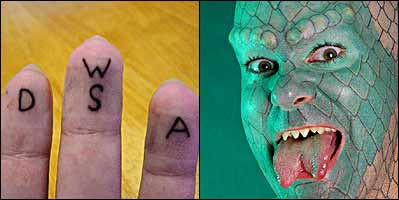
The Lizardman, 32
Performance Artist
 This tattoo was partly motivated by my love of goofy things — especially in otherwise often serious arenas like permanent body modification. I was also interested in exploring an atypical tattoo location (fingertips). The idea of getting a gaming based tattoo was very simple since it is something I really love to do. Outside of sex it is my preferred and driving force when it comes to pleasure oriented experience! This tattoo was partly motivated by my love of goofy things — especially in otherwise often serious arenas like permanent body modification. I was also interested in exploring an atypical tattoo location (fingertips). The idea of getting a gaming based tattoo was very simple since it is something I really love to do. Outside of sex it is my preferred and driving force when it comes to pleasure oriented experience!
Coming up with the idea and being amused by it was enough but I held off for a few months just to be sure I really wanted to do it, as is usual for me. I didn’t see a drawback, so I got it. The idea itself contained all the design elements — to have the standard FPS control keys tattooed on my fingers as if prolonged gaming had imprinted them there.
If you enjoyed this article, you can check out lots more tattoos like these in BME’s Geek Tattoo Gallery. If you’d like to send in your own for that gallery (and get a free membership in return), just email a crisp high-res photo of it to [email protected]. Thanks,

Shannon Larratt
BME.com
|

